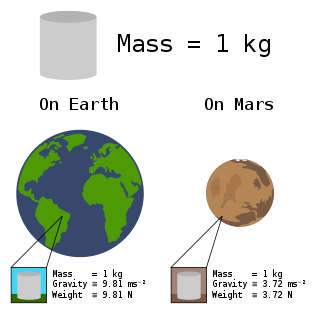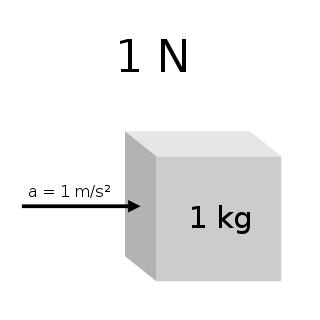
Horsepower (hp) is a unit of measurement of power, or the rate at which work is done, usually in reference to the output of engines or motors. There are many different standards and types of horsepower. Two common definitions used today are the mechanical horsepower, which is about 745.7 watts, and the metric horsepower, which is approximately 735.5 watts.

Measurement is the quantification of attributes of an object or event, which can be used to compare with other objects or events. In other words, measurement is a process of determining how large or small a physical quantity is as compared to a basic reference quantity of the same kind. The scope and application of measurement are dependent on the context and discipline. In natural sciences and engineering, measurements do not apply to nominal properties of objects or events, which is consistent with the guidelines of the International vocabulary of metrology published by the International Bureau of Weights and Measures. However, in other fields such as statistics as well as the social and behavioural sciences, measurements can have multiple levels, which would include nominal, ordinal, interval and ratio scales.

The pound or pound-mass is a unit of mass used in both the British imperial and United States customary systems of measurement. Various definitions have been used; the most common today is the international avoirdupois pound, which is legally defined as exactly 0.45359237 kilograms, and which is divided into 16 avoirdupois ounces. The international standard symbol for the avoirdupois pound is lb; an alternative symbol is lbm, #, and ℔ or ″̶.
The International System of Units, internationally known by the abbreviation SI, is the modern form of the metric system and the world's most widely used system of measurement. Established and maintained by the General Conference on Weights and Measures, it is the only system of measurement with an official status in nearly every country in the world, employed in science, technology, industry, and everyday commerce.

United States customary units form a system of measurement units commonly used in the United States and most U.S. territories, since being standardized and adopted in 1832. The United States customary system developed from English units that were in use in the British Empire before the U.S. became an independent country. The United Kingdom's system of measures was overhauled in 1824 to create the imperial system, which was officially adopted in 1826, changing the definitions of some of its units. Consequently, while many U.S. units are essentially similar to their imperial counterparts, there are significant differences between the systems.

In science and engineering, the weight of an object is the force acting on the object due to acceleration or gravity.

The newton is the unit of force in the International System of Units (SI). It is defined as , the force which gives a mass of 1 kilogram an acceleration of 1 metre per second per second. It is named after Isaac Newton in recognition of his work on classical mechanics, specifically his second law of motion.
The pound of force or pound-force is a unit of force used in some systems of measurement, including English Engineering units and the foot–pound–second system.
The ounce is any of several different units of mass, weight, or volume and is derived almost unchanged from the uncia, an Ancient Roman unit of measurement.
The foot-pound force is a unit of work or energy in the engineering and gravitational systems in United States customary and imperial units of measure. It is the energy transferred upon applying a force of one pound-force (lbf) through a linear displacement of one foot. The corresponding SI unit is the joule, though in terms of energy, one joule is not equal to one foot-pound.
The kilogram-force, or kilopond, is a non-standard gravitational metric unit of force. It does not comply with the International System of Units (SI) and is deprecated for most uses. The kilogram-force is equal to the magnitude of the force exerted on one kilogram of mass in a 9.80665 m/s2 gravitational field. That is, it is the weight of a kilogram under standard gravity. Therefore, one kilogram-force is by definition equal to 9.80665 N. Similarly, a gram-force is 9.80665 mN, and a milligram-force is 9.80665 μN.
The short ton is a measurement unit equal to 2,000 pounds (907.18 kg). It is commonly used in the United States, where it is known simply as a ton, although the term is ambiguous, the single word being variously used for short, long, and metric ton.
The poundal is a unit of force, introduced in 1877, that is part of the Absolute English system of units, which itself is a coherent subsystem of the foot–pound–second system.
A system of units of measurement, also known as a system of units or system of measurement, is a collection of units of measurement and rules relating them to each other. Systems of measurement have historically been important, regulated and defined for the purposes of science and commerce. Instances in use include the International System of Units or SI, the British imperial system, and the United States customary system.
The standard acceleration of gravity or standard acceleration of free fall, often called simply standard gravity and denoted by ɡ0 or ɡn, is the nominal gravitational acceleration of an object in a vacuum near the surface of the Earth. It is a constant defined by standard as 9.80665 m/s2. This value was established by the 3rd General Conference on Weights and Measures and used to define the standard weight of an object as the product of its mass and this nominal acceleration. The acceleration of a body near the surface of the Earth is due to the combined effects of gravity and centrifugal acceleration from the rotation of the Earth ; the total is about 0.5% greater at the poles than at the Equator.
The gravitational metric system is a non-standard system of units, which does not comply with the International System of Units (SI). It is built on the three base quantities length, time and force with base units metre, second and kilopond respectively. Internationally used abbreviations of the system are MKpS, MKfS or MKS . However, the abbreviation MKS is also used for the MKS system of units, which, like the SI, uses mass in kilogram as a base unit.
The foot–pound–second system is a system of units built on three fundamental units: the foot for length, the (avoirdupois) pound for either mass or force, and the second for time.

In common usage, the mass of an object is often referred to as its weight, though these are in fact different concepts and quantities. Nevertheless, one object will always weigh more than another with less mass if both are subject to the same gravity.

A coherent system of units is a system of units of measurement used to express physical quantities that are defined in such a way that the equations relating the numerical values expressed in the units of the system have exactly the same form, including numerical factors, as the corresponding equations directly relating the quantities. It is a system in which every quantity has a unique unit, or one that does not use conversion factors.

The imperial and US customary measurement systems are both derived from an earlier English system of measurement which in turn can be traced back to Ancient Roman units of measurement, and Carolingian and Saxon units of measure.








